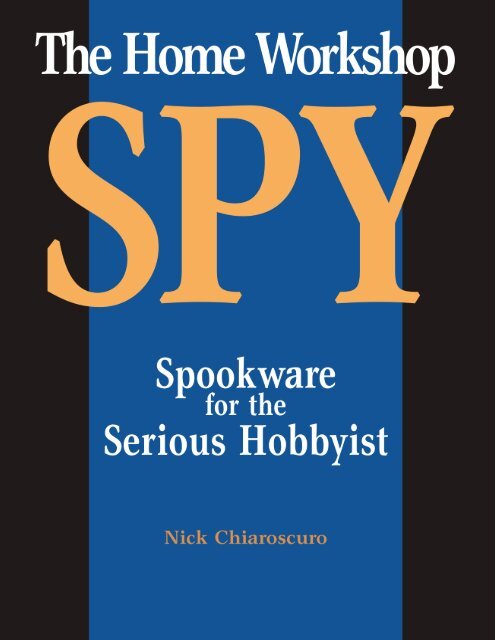to read a free sample chapter from this book. - Paladin Press
to read a free sample chapter from this book. - Paladin Press
to read a free sample chapter from this book. - Paladin Press
You also want an ePaper? Increase the reach of your titles
YUMPU automatically turns print PDFs into web optimized ePapers that Google loves.
WARNINGThis <strong>book</strong> does not intend <strong>to</strong> imply, by its lurid title or its cavalier take on the matter,that electronic surveillance is noble, legal, or safe. It does not seek <strong>to</strong> promote bugging or <strong>to</strong>lure anyone in<strong>to</strong> behavior that could violate the rights of others and subject the perpetra<strong>to</strong>r<strong>to</strong> criminal prosecution. This <strong>book</strong> seeks only <strong>to</strong> inform the <strong>read</strong>er. Those who act upon theinformation contained herein do so at their own risk and entirely on their own responsibility.The author and the publisher specifically disclaim any and all liability and responsibility<strong>to</strong> any party for damage or loss caused, or alleged <strong>to</strong> be caused, directly or indirectly by use,misuse, or inability <strong>to</strong> use the information contained herein. Those who elect <strong>to</strong> build and/oruse these projects do so at their own risk and entirely on their own responsibility.IV
PROJECT NO. 1CORNER DIRECTIONAL MICROPHONEDirectional mikes don’t have <strong>to</strong> be big <strong>to</strong>be effective. They do have <strong>to</strong> deliver gainbased on physical principles rather thansimple exclusion of off-axis sound. Thecorner directional microphone (CDM) usesthe boundary effect <strong>to</strong> achieve 18 dB ofcon<strong>to</strong>ured, directional gain.An ancient but still formidable LM381serves as preamp. Old hands will see in theschematic a twist on the widely hailedCarter-era circuit whose fantastic potentialnever seemed <strong>to</strong> surface in any sort ofwhole and usable <strong>to</strong>ol.All strong sound amps need dynamiccontrol. The CDM uses a true limiter adapted<strong>from</strong> a concept shown in Signetics’ LinearData Manual Volume 1: Communications (p.4-344). It attacks in ~1 msec, decays in ~100msec. It cycles with each peak. Switchingtransients can become intrusive if thresholdis set so low as <strong>to</strong> moderate constant <strong>to</strong>nes.CDM PARTS LISTCapaci<strong>to</strong>rsC1, 6, 20, 24 220 µF aluminumelectrolyticC2, 4, 5, 9, 12, 13, 18 10 µF aluminumelectrolyticC3 2.2 µF aluminum electrolyticC7, 11, 14 100 pF ceramic bypassC8, 17, 19, 22 0.1 µF couplingC10, C21 0.001 µF ceramic bypassC15, 16 150 pF ceramic bypassC23 0.1 µF ceramic bypassResis<strong>to</strong>rsR1 4.7 KR2 200R3 36R4 36 KR5 5 K multiturn miniature trimpotR6 47 KR7, 21 39 KR8, 14, 15, 19 100 KR9, R10 10 KR11 2 KR12 10 K audio-taper potR13 6.8 KR16, 17 100R18 1 MR20 470R22 10 K audio-taper pot w/switchR23 10Semiconduc<strong>to</strong>rsQ1 2N3906 PNP transis<strong>to</strong>rU1 LM381 low-noise dual preamplifierU2 NE570 or NE571 dual compandorU3 LM393 dual compara<strong>to</strong>rU4 LM78L05 5 V positive regula<strong>to</strong>rU5 LM386 audio power amplifierMiscellaneousM1 electret condenser microphone(Panasonic WM52BM [preferred] orRadio Shack 270-090)S1 SPST switch (part of R22)15-volt power source, hardware,enclosure, shielded microphonecable, printed circuit board, etc.3
HOME WORKSHOP SPYCDM Schematic4
CORNER DIRECTIONAL MICROPHONECIRCUIT FUNCTIONElectret condenser microphone M1 getsits bias through R1. M1 output couplesthrough C5 <strong>to</strong> noninverting input of preampU1 configured in single-ended mode bygrounding unused input pin 2. Minimumnoise occurs with 381 input transis<strong>to</strong>rcollec<strong>to</strong>r current at ~170 µa, set externallyby R6 in series with R7. C2 decouples <strong>this</strong>path. Input pins 12-14 of U1’s unusedchannel are grounded.Gain of U1 is set by the ratio of R4 <strong>to</strong>the net impedance of the network formedby R3, R5, C3, and C4. This varies withfrequency, giving a sharp treble emphasis.R5 also sets DC offset of output pin 7. C7rolls off U1’s response above 10 kHz.Output of U1 couples through C8 andR8 <strong>to</strong> input of one channel of U2, configuredfor unity gain in its resting state bythe ratio of R19/R8. C14 limits the highfrequencyresponse of U2’s internal opamp. R19 also sets the DC bias point of U2output pin 7 close <strong>to</strong> 1 ⁄2 V+, preservingmaximum dynamic range.U2 runs on an internal bias of ~1.8volts. This bias is present at pin 3. C13impresses U2’s audio output on the restingbias, tied <strong>to</strong> input pin 2 of dual compara<strong>to</strong>rU3, shunted by C10. A resistive dividerformed by R11, R13, and pot R12, onsupply locally regulated by U4, allows U3trip threshold <strong>to</strong> be altered by R12. R10 isthe compara<strong>to</strong>r pull-up resis<strong>to</strong>r;compara<strong>to</strong>r output couples through R9 <strong>to</strong>base of Q1.When the compara<strong>to</strong>r output is high, Q1is turned off. In <strong>this</strong> state U2’s controlchannel passes audio at unity gain. Whencompara<strong>to</strong>r output goes low, Q1 turns on.This causes U2’s control channel <strong>to</strong> cutgain. Attack is very fast, on the order of amillisecond, set by the time constant of R17and C12. Decay is determined by the timeconstant of C12 and a 10K resistanceinternal <strong>to</strong> U2. R18 leaks current <strong>to</strong> keepC12 partly charged. Input pins 5 and 6 ofU3’s unused compara<strong>to</strong>r are shorted.Signal leaving the limiter channel of U2passes through C17 and R15 <strong>to</strong> the op ampin U2’s second channel, which serves as atape output buffer. Its gain is set at unityby the ratio of R14/R15. C11 limits thehigh-frequency response of the buffer.Signal couples through R16 and C18 <strong>to</strong>tape output. C15 and C16 decouple U2’sinternal supply.Audio also couples <strong>from</strong> U2 pin 7through C19 <strong>to</strong> resistive divider formed byR21 and volume control R22. This dividesout some of the 26 dB voltage gain builtin<strong>to</strong> U5, leaving U1 the gain-determiningelement. Signal couples through C22 <strong>to</strong>noninverting input of U5. C21 shunts RF atU5 input. R20 and C20 decouple U5 <strong>from</strong>the supply; R20 also lowers the 15 V supply<strong>to</strong> about 12 V at U5, allowing 386N-1, -2,and -3 versions <strong>to</strong> run safely. R23 and C23CDM Circuit Board5
HOME WORKSHOP SPYCDM Stuffing and Wiring Diagram6
CORNER DIRECTIONAL MICROPHONECDM Amplifier Pro<strong>to</strong>type7
HOME WORKSHOP SPYform the standard snubber. Audio couplesthrough C24 <strong>to</strong> headphone output jack.R2, C1, C6, and C9 decouple the mainsupply.DETAILSThe mike element mounts face-down inthe corner formed by the intersection ofthree boundaries. Space between mike andboundary should not exceed 1 ⁄16 inch. Thethickness of a dime will do. Secure theelement with glue for permanent use, orsecure just the cable with masking tape forquick disassembly.Construction details are apparent <strong>from</strong>inspection: an open corner with 5-inchsquare sides intersecting at right angles.The pro<strong>to</strong>type used scraps of 1 ⁄8-inch acrylic,but any thin, rigid material will work.Joints should be airtight. Sides as small as3 inches will work; sides as big as a footimprove rejection of ambient noise.Apply power, trim R5 <strong>to</strong> give 1 ⁄2 V+ at pin7 of U1.Before donning the phones it’s a goodidea <strong>to</strong> set limiter threshold at minimum(R12 full CCW). Adjust limit threshold forexisting conditions.Raw capsule output of <strong>this</strong> configurationis about eight times that of the same mikeelement mounted in a “shotgun” directionalmike. The preamp is con<strong>to</strong>ured for greatestgain in the speech band (300 <strong>to</strong> 6000 Hz).Coupled <strong>to</strong> EQ supplied by the boundary,the system needs no highpass filter despitecondenser mikes’ great bass response.Like any serious directional piece, theCDM should not be hand-held or used in anoisy milieu. It works best mounted on atripod on a cold, still night.So here it is: tweaked for speech, in fullspook trim, rebiased for battery power, amere 20 years <strong>to</strong>o late, the ancient classicnow born of flesh, the one—the only—LM381 “ultra-low-noise preamplifier.”8
















